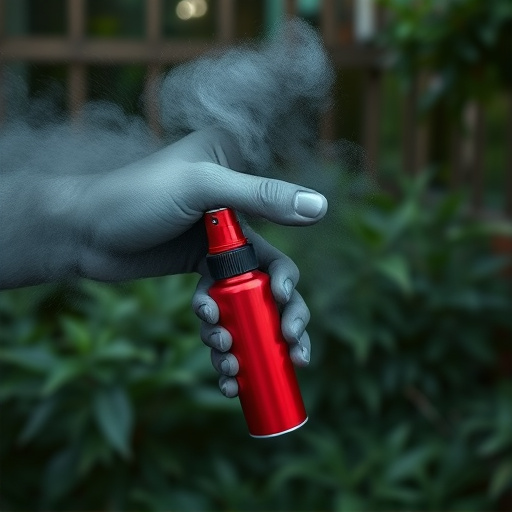Capsaicin, a natural anti-inflammatory agent found in chili peppers, is an effective non-invasive treatment for pain and inflammation due to its unique mechanism of action. The "Spray and Move" technique leverages capsaicin spray deterrents to disrupt individuals' balance and vision briefly, allowing swift evasive action without direct contact. These sprays have practical applications in self-defense, law enforcement, border control, and private security for crowd control and disrupting criminal activities. Safe handling practices, including post-exposure decontamination, are crucial due to potential risks associated with capsaicin spray use, highlighting the importance of comprehensive Spray and Move Deployment Techniques training.
“Discover the power of capsicum as an innovative deterrent in security measures. This article explores how capsaicin, the active compound in chili peppers, acts as a potent anti-inflammatory agent when utilized in spray form. We delve into the strategic deployment techniques known as ‘Spray and Move,’ offering a unique approach to deterring unauthorized access. By examining its practical applications and safety considerations, readers will gain insights into this non-lethal solution, especially effective for crowd control and perimeter security.”
- Understanding Capsaicin and Its Anti-Inflammatory Properties
- Spray and Move Deployment Techniques: A Strategic Approach
- Practical Applications and Safety Considerations for Capsaicin Spray Deterrents
Understanding Capsaicin and Its Anti-Inflammatory Properties
Capsaicin, the compound responsible for the heat and pungent sensation in chili peppers, has long been recognized for its unique properties. Beyond its sensory effects on taste receptors, capsaicin is a powerful inflammatory agent deterrent known to interact with specific cells in the body’s immune system. When deployed as a spray, it offers an innovative approach to managing inflammation and pain without pharmaceuticals.
This natural compound selectively targets pro-inflammatory neutrophils and macrophages, reducing their infiltration at sites of injury or irritation. The anti-inflammatory properties are multifaceted; capsaicin inhibits prostaglandin production, blocks nerve signal transmission, and promotes the release of endorphins, our body’s natural painkillers. This complex interaction contributes to its effectiveness in various applications, making it a preferred choice for non-invasive pain management and anti-inflammatory interventions, especially when utilizing advanced deployment techniques like sprays and move methods.
Spray and Move Deployment Techniques: A Strategic Approach
In the strategic deployment of a Capsaicin Inflammatory Agent Deterrent Spray, the “Spray and Move” technique is a highly effective approach. This method involves a swift and precise application of the spray, immediately followed by a calculated retreat to a safe distance. The key lies in timing; spraying at close range for a few seconds disrupts an individual’s sense of balance and vision, allowing for a quick escape or re-positioning without direct physical contact.
This strategic technique leverages the spray’s ability to create a temporary but powerful deterrent, providing crucial time for evasive action. By combining the offensive nature of the spray with tactical retreat, it becomes a game-changer in security protocols, especially in navigating dense populations or high-risk scenarios, ensuring the safety and swift movement of individuals while deterring potential threats effectively.
Practical Applications and Safety Considerations for Capsaicin Spray Deterrents
Capsaicin spray deterrents have found practical applications in various fields, primarily as a non-lethal self-defense option for individuals and security personnel. Their ability to cause a burning sensation and temporary blindness makes them effective deterrents against potential threats. These sprays are often used by law enforcement agencies, border control, and private security firms for crowd control and to disrupt criminal activities.
When deploying capsaicin spray, understanding different spray and move deployment techniques is crucial for safety and effectiveness. The user should aim for the eyes and face, as these areas are highly sensitive to capsaicin. Rapid movement after spraying ensures minimal inhalation of the chemical, reducing respiratory irritation. Training in safe handling practices, including proper ventilation and post-exposure decontamination procedures, is essential to mitigate any potential risks associated with capsaicin spray use.
Capsaicin spray deterrents, with their unique Spray and Move deployment techniques, offer a strategic approach to managing various situations. By understanding capsaicin’s anti-inflammatory properties and implementing safety considerations, these tools prove practical in numerous applications. This natural agent provides an effective deterrent while ensuring user safety and comfort.
